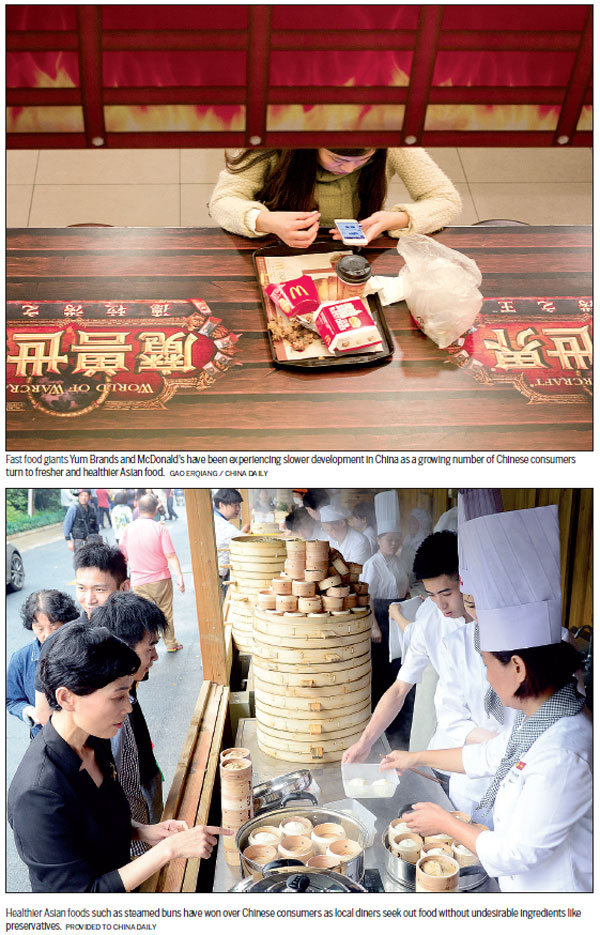News&Insights
- The power of play: Toymaker Pop Mart debuts on Hong Kong market
- Beauty skin deep, and pockets lined
- Crackdown on excess wrapping in parcel delivery industry to start soon
- Ready-to-eat meals a niche for big-name restaurants
- Consumption upgrade bringing new boon to top-end rice producers
- Arrow sews up 10-year expansion plan
- Chain operations buck trend to expand
ASK AND QUESTION
Lawyers Article
A change in game plan
Source: franchise lawyer network Author: Beijing lawyers Time: 2017-02-14
Faced with stern competition from local rivals, a slowing China economy and healthy dining trends, McDonald's and its fiercest rival
Yum Brands have been forced to rethink their strategies in the world's largest fast food market
Found at almost every major street corner across thousands of cities in China, McDonald's and fast food outlets under Yum Brands such as KFC and Pizza Hut have long enjoyed a run of super-sized growth as local consumers craved a taste of Americana.
The two fast food giants used to define China's fast food segment, with the duopoly accounting for more than half of the market share in a country that has the world's largest food service industry.

It is hence unsurprising that both companies have now decided to shed their once lucrative Chinese assets at a similar timing, leaving people wondering whether their dominance over the past two decades has inevitably faded.
After a prolonged struggle to attract buyers, McDonald's announced in January that it would sell 80 percent of its shares in the Chinese mainland and Hong Kong to Chinese investment conglomerate CITIC Group, CITIC Capital and Carlyle Group. The move will give the buyers a controlling stake in the brand's chains in the region.
Phyllis Cheung, CEO of McDonald's in China, said the move would help unlock more capital as part of the company's turnaround plan. She sees the franchise model as an effective way to spur growth potential in China's third- and fourth-tier cities, and improve flagging performance in existing stores.
"Financial strength" and "unmatched understanding of the local market", said Cheung, were the reasons the fast food giant decided to pick the CITIC-led consortium.
"CITIC's real estate networks and strategic alliances with developers including Vanke and China Resources may potentially open up more opportunities," said Cheung.
Meanwhile, Yum has also decided to separate its Chinese entities, albeit using a different approach: initial public offering. In November, the fast food giant spun off its China business in a New York Stock Exchange listing, with Yum China being a licensee of its parent company.
The floating plan would give Yum China, which manages 7,500 KFC, Pizza Hut, Little Sheep and East Dawning stores, the flexibility to react to the fast-changing market, said CEO Micky Pant.
Despite their sizable businesses, both firms have felt the pinch as sales stagnate in a country that once boosted the balance sheets. Bloomberg data showed that Yum's China unit had accounted for half of the company's global sales by 2012, but growth has since stalled.
For McDonald's, its third-quarter operating income in high-growth markets, which includes China, registered less than 15 percent of total sales in 2016, according to its financial statement.
Yum's market share had also dropped precariously from 40 percent in 2012 to 30.2 percent in 2015. McDonald's share slid as well, from 16.5 percent in 2013 to 13.8 percent in 2015, said a consultant at Euromonitor International.
Meanwhile, upstart rivals have been quick to wrest market share by answering the call from consumers for fresher and healthier food in Asian flavors. According to market research firm Mintel, tangbao (steamed dumplings), Japanese noodles and steamed-rice meals are quickly gaining popularity in China.
Mintel also forecast that independent brands will experience a compound annual growth rate of 10.4 percent while fast food chains will register only 4.7 percent. It attributed this to the fact that independent outlets are able to faster adapt to the healthy dining trend.
Reinventing strategies
The economic slowdown in China has compelled the pair to reposition their strategies. Besides having identified breakfast offerings and dessert kiosks as a growth catalyst in fast-paced cities like Beijing and Shanghai, the two fast food giants also have their sights trained on China's hinterlands which they believe are pivotal to future growth.
McDonald's is expected to depend on its Chinese partners to penetrate the lower-tier cities, with a goal of adding 1,500 stores over the next five years.
"Expansion requires a lot of resources, including finding suitable locations, negotiating the rent and finding the right type of landlord. CITIC Bank's 1,400 branches across China would be able to better share resources and help with the expansion," said Zhang Yichen, chairman and CEO of CITIC Capital, who will chair McDonald's China business.
Yum is rolling out an even more ambitious plan to open 600 new stores yearly over five years. Pant said that the main focus of this expansion will be on lower-tier cities and transportation hubs like railway stations and airports.
Qi Xiaozhai, a senior business consultant for the Shanghai Municipal Commission of Commerce, said that quick service restaurants still have much room for growth in lesser developed cities and townships in China because they are still a novelty. In contrast to bigger cities where consumers see fast food outlets as a quick-fix for hunger, quick service restaurants in lower tiered cities are still popular venues for socializing.
"We have decided to include more playgrounds for children in our restaurants in lower tier cities as we've noticed that having a meal at a McDonald's in such places is a family affair," Cheung said.
As part of Yum's expansion efforts, Pant has decided to bring the Mexican-themed chain Taco Bell back to China following its failed attempt in 2003. He has chosen Shanghai's Lujiazui financial hub as the testing ground for Taco Bell's revival, noting that the location has an ideal combination of travelers, businessmen and consumers from the younger generation. The restaurant has also tweaked its offerings to better cater to the local palate.
Another strategy that Yum and McDonald's have adopted is to be more mobile by embracing digital channels for sales and delivery services. The two giants have already introduced cashless payment methods by teaming up with China's most popular e-wallet service providers Alipay and WeChat Pay and have been enticing customers with coupons available on such platforms.
In-store self-help ordering kiosks have also allowed customers to choose whether they want to dine-in or take-away with a few taps on the screen.
"KFC and McDonald's can still enhance their digital offerings to help shorten queue times or offer more up-market products like what Yum is already doing with Taco Bell's range of coffee products and kiwi salads," said Shaun Rein, managing director of China Market Research Group.
On the express delivery front, both have run or invested in courier services to tap into the growing trend of dining at home. However, the pair faces a stern challenge from local food ordering and delivery platforms like ele.me.
"Chinese consumers are pampered by the faster, wider and cheaper choices of food in China. Meanwhile these sites also have healthier options which are becoming more popular among all demographics today," said Rein.
Health above all
For the past two decades, fast food was seen as hip, fashionable and forward-thinking, but this is no longer the sentiment as an increasing number of consumers are jumping on the healthy eating bandwagon.
A McKinsey survey last year showed that Chinese customers' adoption of Western fast food had dropped from 67 percent in 2012 to 51 percent in 2015. The consumption of carbonated soft drinks and ice cream had also fallen by 21 percent and 7 percent respectively.
Zhang Jianchen, 34, an insurance broker in Shanghai, said that she cannot even remember the last time she stepped into a KFC or McDonald's.
"I won't eat hamburgers or fries if there's an alternative. Just think about the calories these foods have," said Zhang, who exercises three times a week and refrains from consuming fried food.
In this age when consumers are demanding more information about ingredient sourcing and food preparation, greater transparency will be crucial for fast food outlets to maintain their market share, said industry experts.
"For fast food brands, embracing the trend of healthy and experiential dining is the key to growth in the near future. In the meantime, staying innovative can help to win over young consumers," said Summer Chen, research analyst at Mintel.
To this end, the new Taco Bell store in Shanghai features an open-concept kitchen that puts its ingredients and food preparation processes in full view of the diners.
Yum and McDonald's will face strong competition from their local rivals. East Dawning, a fast-food chain under Yum known for its healthier, Chinese-style offerings, saw its presence shrink to just 15 stores across China, according to its IPO prospectus. In contrast, its main rivals Zhen Kungfu has 603 outlets while Daniang Dumpling has 465.
Rein believes that the likes of McDonald's and Yum can still experience solid growth in the years to come, though it won't be as prolific as during the 1990s. He pointed out that chains like Starbucks prove that the maturing middle class in China will always seek out authentic Western dining experiences.
"Chinese consumers want to try something different and feel like they are sophisticated and part of the global elite. That's what Starbucks gives them. That's what Western brands need to tap into," he said.
hewei@chinadaily.com.cn

(China Daily USA 02/10/2017 page8)

 京公网安备:
京公网安备:
